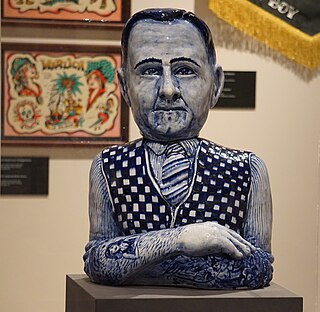
Heinrich John Rickert was a German philosopher, one of the leading neo-Kantians.

Iry-Hor was a predynastic pharaoh of Upper Egypt during the 32nd century BC. Excavations at Abydos in the 1980s and 1990s and the discovery in 2012 of an inscription of Iry-Hor in Sinai confirmed his existence. Iry-Hor is the earliest ruler of Egypt known by name and is sometimes cited as the earliest-living historical person known by name.

The Battle of Frankenhausen was fought on 14 and 15 May 1525. It was an important battle in the German Peasants' War and the final act of the war in Thuringia: joint troops of Landgrave Philip I of Hesse and Duke George of Saxony defeated the peasants under their spiritual leader Thomas Müntzer near Frankenhausen in the County of Schwarzburg.

Count Frederick of Isenberg was a German noble, the younger son of Arnold of Altena. Before the split between Arnold of Altena-Isenberg the eldest and his brother Friedrich Altena-Mark the younger son of Everhard von Berg-Altena. His family castle was the Isenberg near Hattingen, Germany.

Aryanization was the Nazi term for the seizure of property from Jews and its transfer to non-Jews, and the forced expulsion of Jews from economic life in Nazi Germany, Axis-aligned states, and their occupied territories. It entailed the transfer of Jewish property into "Aryan" or non-Jewish hands.

A hammer mill, hammer forge or hammer works was a workshop in the pre-industrial era that was typically used to manufacture semi-finished, wrought iron products or, sometimes, finished agricultural or mining tools, or military weapons. The feature that gave its name to these workshops was the water-driven trip hammer, or set of hammers, used in the process. The shaft, or 'helve', of the hammer was pivoted in the middle and the hammer head was lifted by the action of cams set on a rotating camshaft that periodically depressed the end of the shaft. As it rose and fell, the head of the hammer described an arc. The face of the hammer was made of iron for durability.
Hamburger Hafen und Logistik AG, known until 2005 as Hamburger Hafen- und Lagerhaus-Aktiengesellschaft, and prior to that as Hamburger Freihafen-Lagerhaus Gesellschaft (HFLG) since 1885, is a German logistics and transportation company specialising in port throughput and container and transport logistics.
Gerd Weisgerber was an eminent German professor of mining archaeology. He was one of the first mining archaeologists of the world, who set standards in this scientific discipline. As a scientist from the German Mining Museum, he focused his research mainly on Western Asia, especially on Oman, Jordan, Palestine, and Iran.

Friedrich Wilhelm Otto Modersohn was a German landscape painter. He was a co-founder of the Art Colony at Worpswede.

Theodor Bartus was a German sailor, museum technician, and conservator. Bartus was the son of a master weaver. He began his nautical career on the sailing ship of his uncle. In Australia, he passed his First mate exam and became captain. He acquired many years of experience sailing ships. At times, he lived as a squatter in Australia.

Christian Warlich was a Hamburg based tattooist who professionalised tattooing in Germany. He supposedly was the first one to use an electric tattoo machine in Germany.

The English Church is a former Church of England church building in the German city of Bad Homburg in Hesse. It is listed as a historic monument and now houses a cultural centre.
Wolfgang Kermer is a German art historian, artist, art educator, author, editor, curator of exhibitions, art collector and professor. From 1971 to 1984 he was repeatedly elected Rector of the State Academy of Fine Arts Stuttgart and thus the first scientific and at the same time youngest teacher in this position in the history of the university. Under his rectorate, the State Academy of Fine Arts Stuttgart was reformed in 1975 and 1978 on the base of two new university laws of the State of Baden-Württemberg and thus, for the first time in its history, authorized to set up diplomas for all courses. One of the accents of his work was the promotion of talented graduates of the academy: In 1978 he organized the first of the so-called ″debutant exhibitions″, an ″unconventional contribution to the promotion of young people″, supported financially by the State of Baden-Württemberg.

Knüffeln is a very old trick-taking card game for four players, playing in pairs, that is still played in North Germany. Once considered the national game of Frisia, Knüffeln is a descendant of Karnöffel, the oldest identifiable European card game in the history of playing cards with a continuous tradition of play down to the present day.
Michael Reudenbach is a German composer. He performs as an interpreter of Early and New Music.

The Jewish Museum of Switzerland in Basel provides an overview of the religious and everyday history of the Jews in Basel and Switzerland using objects of ritual, art and everyday culture from the Middle Ages to the present.
Heinrich Ferdinand Mannstein, real name Heinrich Ferdinand Steinmann, was a German singing teacher, writer and music critic.

Wilibald Nagel (also Willibald Nagel, was a German musicologist and music critic.
Winfried Schrammek was a German musicologist and organist.
Werner Franz Josef Wilhelm Detlev Bornheim gen. Schilling was a German art historian and historic preservationist. From its establishment in 1946 until 1980, he headed the General Directorate for Cultural Heritage Rhineland-Palatinate and the administration of the state palaces of Rhineland-Palatinate or their predecessor institutions as Landeskonservator.














